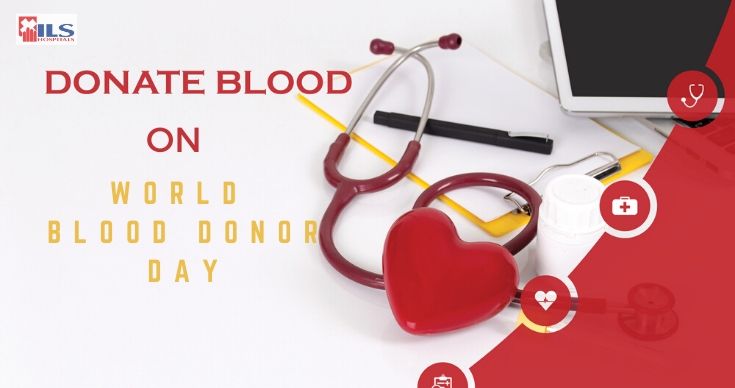World Blood Donor Day: Donate Plasma to Save lives
Donation is the most beautiful thing ever known to humankind. Blood donation is the key to saving lives. When you donate blood, you not only save people’s lives but also your own as blood donation provides the donor with additional health benefits. Upon that, let’s not forget how fulfilled your life would become once you save another human’s life. Today, ILS Hospitals, one of the best hospitals in Kolkata and Agartala will enlighten you on plasma donation.
Plasma is the yellowish part of the blood and performs vital functions, like transporting nutrients to the body parts and fighting infection. Donating plasma has been called the gift of life. Donating plasma helps in providing therapies for rare diseases and conditions. Plasma therapy has been found effective in treating critically-ill COVID-19 patients. Plasma donation is the need of the hour. You can donate plasma in two ways:
1st way – by donating your whole blood so that the plasma gets separated from the blood in the laboratory.
2nd way – by donating only the plasma through the process of plasmapheresis.
Plasma donation not only helps the recipient but also the donor. Here’s how.
Free health checkup from expert medical professionals
Before you donate plasma, your body will be thoroughly examined by the medical professionals to check your health status. This way you’ll be ensured of your body’s well-being.
Improves health
Plasma donation will motivate you to take better care of your body. Upon that, if you’re diagnosed with any health condition during your mini health check-up, you’ll get instant medical attention from the doctors.
Reduces bad cholesterol
Bad cholesterol is a generic problem. Plasma donation might help in the reduction of bad cholesterol.
Benefits psychological health
When you help others, you help yourself. When you find that your plasma has saved someone’s life you’ll get instant psychological satisfaction.
As we have mentioned earlier, plasma therapy has been found helpful in treating serious Coronavirus patients. In Convalescent plasma therapy, the plasma is extracted from recovered COVID-19 individuals for providing treatment to critically-ill COVID-19 patients. Plasma contains antibodies that help in fighting foreign pathogens. The ones who have recovered from COVID-19 are now immune to the virus and by using their plasma we can save others from this deadly Coronavirus.
If you’ve recovered fully from COVID-19 and are willing to donate your plasma to save lives, visit your nearest blood collection centre. ILS Hospitals in Agartala and Kolkata applauds such brave hearts who have donated their plasma to give people the gift of life.
A Brief Introduction to the Types of Blood Donation
Blood transfusion is a process of supplying blood of a matching group to an individual in need of it. Even though advanced procedures such as laparoscopic surgery rarely needs a blood transfusion, it is needed for medical emergencies, life support systems, several specific diseases, such as thalassemia, or even a major pre-scheduled invasive surgery.
Whether or not you have been a part of blood transfusions, you are more likely to be accustomed to only one type of blood donation. However, did you know that there are 4 types of blood donations, as per the element of the blood? Let’s have a quick look at each of them
1. Whole blood donation
The most common procedure, in which about a pint of whole blood is extracted out of the body. It may or may not be further segregated into platelets, plasma, and red cells, depending upon the need of the recipient. The procedure takes about half an hour or even less, while the patients can donate the same every 2 months.
2. Platelet Apheresis
It requires a special apheresis machine that collects blood and separates all its elements with centrifugal effect. The platelets component is kept for transfusion while the remaining elements return back to the body’s blood circulation. The process takes about 2 hours.
This type of blood is needed by patients battling cancers, undergoing organ transplant therapy and surgeries/medical emergencies that may involve massive bleeding. Moreover, while a single platelet donation can be used for multiple blood transfusion, it takes about 5-6 whole blood donations to make up for a single platelet transfusion. It can be donated every seven days, up to 24 times a year.
3. Plasma Apheresis
This type of blood donation goes simultaneously with the previous one. In this type, only the plasma is kept for the blood transfusion, while the rest is returned back to the body. The process takes about an hour and a half. It can be done after every two weeks.
4. Power Red
This one is yet another donation type involving the apheresis machine, which collects only the red cells while it returns the plasma and the platelets. Often the rare blood types have short supply as the donor need to meet few special guidelines for donating this type. It includes having higher levels of haemoglobin and specific body height and weight.
A single donation usually takes about an hour and collects two units of red cells. The donor can contribute every 120 days.
Each blood donation types has its own features. On this World Blood Donor Day, 14th June we honour every blood donor and feel our duty to pay tribute to one particular donor named James Harrison of Australia. This blood plasma donor rightfully earned the title of ‘man with the golden arm’ as he has donated blood plasma 1173 times throughout his entire life. After receiving 13 liters of blood for a surgery at the age of 14, he committed to donate blood in the future. Having a rather strong antigen against the group Rh antigen, he was able to donate blood plasma, which as per estimation, saved about 2.4 million unborn babies.

While saluting such a determined spirit, we, on behalf of ILS Hospitals, urge every healthy, capable individual to donate blood, at least once in their lifetime.












